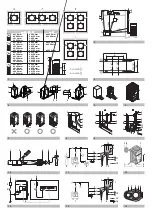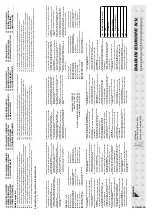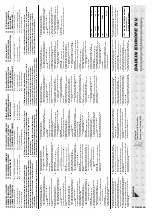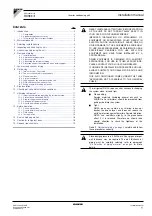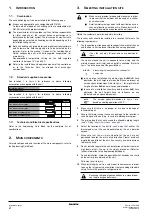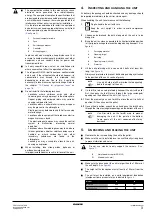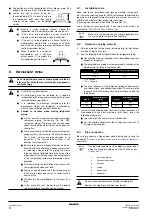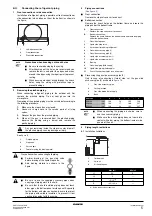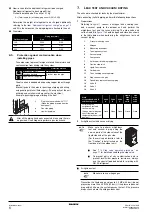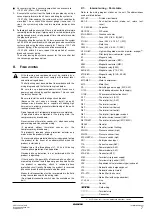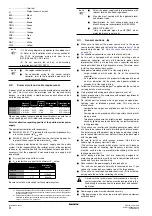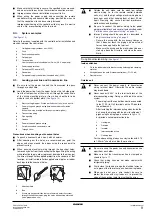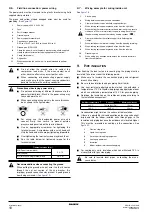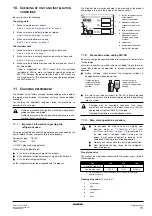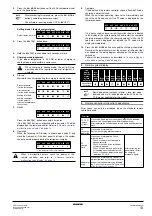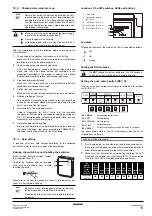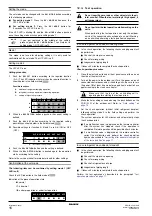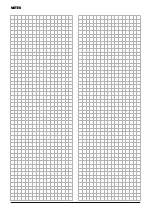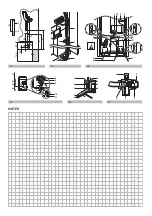
Installation manual
10
ERX125~250A7W1B
Inverter condensing unit
4PW30064-1D
8.6.
Field line connection: power wiring
The power cord must be clamped to the plastic bracket using field
supplied clamp material.
The green and yellow striped wrapped wires must be used for
grounding.
8.7.
Wiring example for wiring inside unit
9.
P
IPE
INSULATION
After finishing the leak test and vacuum drying, the piping must be
insulated. Take into account the following points:
■
Make sure to insulate the connection piping and refrigerant
branch kits entirely.
■
Be sure to insulate liquid and gas piping (for all units).
■
Use heat resistant polyethylene foam which can withstand a
temperature of 70°C for liquid side piping and polyethylene foam
which can withstand a temperature of 120°C for gas side piping.
■
Reinforce the insulation on the refrigerant piping according to
the installation environment.
Condensation might form on the surface of the insulation.
■
If there is a possibility that condensation on the stop valve might
drip down into the indoor installed units through gaps in the
insulation and piping because the outdoor unit is located higher.
This must be prevented by sealing up the connections. See
■
For cooling only units, insulation which can withstand 70°C is
also sufficient for gas side piping.
1
Power supply (400 V, 3 N~50 Hz)
2
Fuse
3
Earth leakage breaker
4
Grounding wire
5
Power supply terminal block
6
Connect each power wire
RED to L1, WHT to L2, BLK to L3 and BLU to N
7
Ground wire (GRN/YLW)
8
Clamp the power wire to the plastic bracket using a field supplied
clamp to prevent external force being applied to the terminal.
9
Clamp (field supply)
10
Cup washer
11
When connecting the earth wire, it is recommended to perform
curling.
■
Do not allow the ground wires to contact the
compressor lead wires. If the wires contact each
other, adverse effects may occur to other units.
■
When connecting or disconnecting a power supply
cord, make sure that the current-carrying conductors
become taut before the earthing conductor.
Precautions when laying power wiring
■
Do not connect wiring of different thicknesses to the
power terminal block. (Slack in the power wiring may
cause abnormal heat.)
■
When connecting wiring which is the same thickness,
do as shown in the figure below.
■
For wiring, use the designated power wire and
connect firmly, then secure to prevent outside
pressure being exerted on the terminal board.
■
Use an appropriate screwdriver for tightening the
terminal screws. A screwdriver with a small head will
strip the head and make proper tightening impossible.
■
Over-tightening the terminal screws may break them.
■
See the table below for tightening torque for the
terminal screws.
Recommendations when connecting the ground
When pulling the ground wire out, wire it so that it comes
through the cut out section of the cup washer. (An
improper ground connection may prevent a good ground
from being achieved.)
Tightening torque (N•m)
M8 (Power terminal block)
5.5~7.3
M8 (Ground)
M3 (Inter-unit wiring terminal block)
0.8~0.97
1
Electric wiring
2
Wiring between outdoor unit and control box
3
Clamp to the electric box with field supplied clamps.
4
When routing out the power/ground wires from the right side:
5
When routing the remote control cord and inter-unit wiring, secure
clearance of 50 mm or more from the power wiring. Ensure that
the power wiring does not contact any heated sections (
).
6
Clamp to the back of the column support with field supplied
clamps.
7
When routing out the inter-unit wirings from the opening for piping:
8
When routing out the power/ground wires from the front:
9
When routing out the power/ground wires from the left side:
10
Grounding wire
11
When wiring, pay attention not to detach the acoustic insulators
from the compressor.
Ambient temperature
Humidity
Minimum thickness
≤
30°C
75% to 80% RH
15 mm
>30°C
≥
80 RH
20 mm
1
Gas line stop valve
2
Liquid line stop valve
3
Service port for adding refrigerant
4
Sealing up treatment
5
Insulation
6
Indoor -outdoor interconnection piping
Be sure to insulate local pipes, as touching them can
cause burns.


